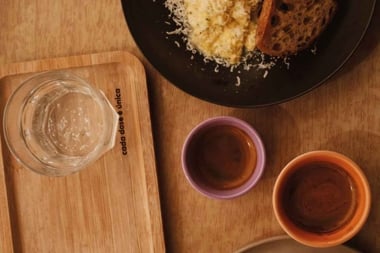Fabulous Facial Masks

Facial masks are a luxurious answer to dry, tired-looking skin. No matter what the condition of your skin is--dry, oily, blemished or a combination--there are facial masks that will work wonders.
Facial masks are a luxurious answer to dry, tired-looking skin. No matter what the condition of your skin is–dry, oily, blemished or a combination–there are facial masks that will work wonders.
Several good natural facial masks are available in health food stores. If you have the time, you can even make some yourself. Raid your local garden or organic food store for the edible ingredients you’ll need. (If you don’t have time to make the masks yourself, look for products that contain the ingredients mentioned here.) These masks are not only beneficial to your skin, they taste great, too!
Recently I read that most men have softer facial skin than most women. The article explained that this smoothness was caused by the exfoliation effect (scraping of dead skin cells) of daily shaving. Using a variety of facial masks a few times a week can provide exfoliation benefits like smooth, glowing skin, as well as improved skin tone and circulation.
A simple mask for deep cleansing and toning is a mix of one-quarter cup (63 mL) yogurt with two tablespoons (30 mL) of oatmeal. As with most masks, massage on and leave for 15 to 20 minutes. When your facial mask starts to "pull," (tighten your facial skin) remove it. Rinse with lukewarm water. Finish with cool water.
Oatmeal, barley flakes or clay powder are all great bases for a mask. Each of these is effective at drawing toxins from your tissues.
Clay is the probably the most common base for a facial mask. Clay contains a variety of oxidized minerals, including trace minerals. The combination of these elements result in different colors of clay that offer a variety of therapeutic benefits. Of the clay powders, green clay (the most therapeutic) is often used for blemished or oily skin, while the rose is used on dry skin. White clay is often used on combination skin, being more neutral.
Non-allergenic, astringent, antiseptic, analgesic and anti-inflammatory, clay also promotes skin regeneration through improving circulation and drawing impurities from your skin. Clay masks can be made with only the addition of water for oily skin. If your skin tends to be dry, then add cream, yogurt, milk or a cold-pressed olive or almond oil to moisturize and soften.
Skin That’s Just Peachy
If you want more of a pick-me-up try mashing one-quarter cup (63 mL) of fresh strawberries with one and one-half teaspoons (7 mL) each of milk and rice flour, arrowroot, potato starch or cornstarch. This mask moisturizes, softens and lightens the skin, as well as removes dead cells.
How about mashing a fresh peach with a bit of yogurt or milk? This is great for dry skin! Applesauce (unsweetened) is amazing on chapped skin–it exfoliates, tones and softens. Avocados, raspberries, papayas and melons all soothe, moisturize and tone your skin. Any of these can also be mixed with clay or oatmeal for deeper cleansing effect. Melons work best applied in thin slices.
Cucumber makes a wonderfully hydrating mask for your skin-it’s especially beneficial around the eyes, reducing puffiness and dryness. Masks made with clay or grains should never be applied near the eyes. Use only highly moisturizing blends for the eye area.
Speaking of the eyes, try grating a potato or cabbage and packing that over your eye. Potatoes, cabbage or even mashed tofu will pull toxins and impurities from your skin. These will reduce those black lines under your eyes.
Carrots have a lot to offer any skin type, being rich in vitamin A, the skin’s favorite vitamin. Save carrot pulp from your juicer or blend two tablespoons (30 mL) of fresh carrot juice with two tablespoons (30 mL) of powdered buttermilk and leave on the skin for 15 to 20 minutes.
Tomatoes are good for reducing oil and blackheads. Spread fresh tomato juice over your face. Let sit for 10 minutes, then rinse well with lukewarm water. Yellow tomatoes work best on sensitive skin, because of the lower acid content in them.
Invigorate Your Face
For added perks like increased circulation, add lavender, geranium, rose or jasmine to a mask for dry or normal skin. Oily skin is helped by more powerful essential oils like juniper, rosemary, tea tree and citrus. Acne is improved with the addition of a drop of mint or camphor to a mask. An important note: add only one drop of the stronger essential oils like mint, juniper, camphor, jasmine or rose. Adding more can stimulate the skin into a prickly, burning sensation. (Ask me, I’ve done it. Yeeow!) With essential oils, less is more. Keep that in mind when adding essential oils to your bath.
Unpasteurized honey can be used in any of your masks. It’s nutritious, toning, antiseptic and will help pull toxins out of your skin. Honey tends to drip, though, so keep still while using a mask with honey in it, or else you’ll look like one of those creatures featured on late night television.
Eggs can also be used to benefit every type of facial skin. For dry or normal skin, mix a raw egg with either one tablespoon (15 mL) of honey or one teaspoon (five mL) of yogurt. One egg white with a tablespoon (15 mL) of oatmeal helps oily skin and removes blackheads, too. With any of these, spread on and leave for 15 to 20 minutes, then rinse well with tepid water.
Whenever you use a mask, remember that what is applied to the skin will also be absorbed into the skin. Use fresh, natural, organic ingredients to cleanse, tone and nourish your skin. (This is a good rule for makeup and perfumes as well.) Radiant, youthful, skin may be easier–and tastier–than you think!




